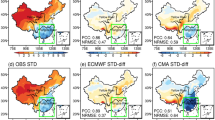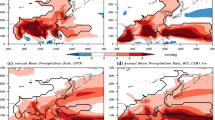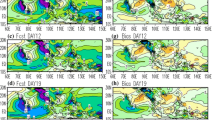Abstract
Based on deterministic and probabilistic forecast verification, we investigated the performance of three subseasonal-to-seasonal (S2S) operational models, i.e., the model of the European Centre for Medium-Range Weather Forecasts (ECMWF) and two models of the China Meteorological Administration (CMA1.0 and CMA2.0), in the extended-range forecast of extreme rainfall over southern China (SCER) while considering the modulation of 10–30-day boreal summer intraseasonal oscillation (BSISO2). The Heidke Skill Score (HSS) of the SCER in the ECMWF, CMA2.0, and CMA1.0 models decreased to less than 0.1 at lead times of 13, 9, and 6 days, respectively. Similarly, the useful prediction skill of the BSISO2 index in the ECMWF, CMA1.0, and CMA2.0 models was up to 15, 13, and 8 days in advance, respectively. The BSISO2’s phase error, rather than the amplitude error, determines its prediction skill. The HSS of the BSISO2 index is significantly correlated with that of SCER in all three S2S models, suggesting that the prediction skill of SCER is influenced by that of BSISO2. The ECMWF shows much higher skill than the two CMA models do in predicting the SCER probability changes under the influence of BSISO2 during Phases 5–7, with the useful prediction skill having up to a 10-day lead time. In contrast, CMA1.0 and CMA2.0 can only predict the modulation of BSISO2 on the SCER probability within a week. The prediction skill of BSISO2’s modulation on SCER largely relies on moisture convergence, rather than on moisture advection. This study highlighted the importance of model’s accurate representation of BSISO2 and its associated moisture convergence for improving extended-range forecast of SCER.













Similar content being viewed by others
Data availability
The daily outgoing longwave radiation (OLR) data from the National Oceanic and Atmospheric Administration (NOAA) is available at https://psl.noaa.gov/data/gridded/data.uninterp_OLR.html. CN05.1 data is obtained from the China Meteorology Administration’s National Climate Center. The Asian Precipitation Highly Resolved Observational Data Integration Towards Evaluation (APHRODITE) gridded precipitation are retrieved from https://climatedataguide.ucar.edu/climate-data/aphrodite-asian-precipitation-highly-resolved-observational-data-integration-towards. The daily mean geopotential height, zonal and meridional wind provided by ERA5 are openly available at https://www.ecmwf.int/en/forecasts/dataset/ecmwf-reanalysis-interim. The reforecast data from the operational S2S models can be downloaded from https://confluence.ecmwf.int/display/S2S.
References
Bo Z, Liu X, Gu W et al (2020) Impacts of atmospheric and oceanic initial conditions on boreal summer intraseasonal oscillation forecast in the BCC model. Theor Appl Climatol 142:303–406. https://doi.org/10.1007/s00704-020-03312-2
Dee D, de Uppala P et al (2011) The ERA-Interim reanalysis: configuration and performance of the data assimilation system. Q J R Meteorol Soc 137:553–597. https://doi.org/10.1002/qj.828
Gottschalck J, Wheeler M, Weickmann K et al (2010) A framework for assessing operational Madden-Julian oscillation forecasts: a CLIVAR MJO Working Group project. Bull Am Meteorol Soc 91:1247–1258. https://doi.org/10.1175/2010BAMS2816.1
He H, Yao S, Huang A, Gong K (2020) Evaluation and error correction of the ECMWF subseasonal precipitation forecast over eastern China during summer. Adv Meteorol 2020:1–20. https://doi.org/10.1155/2020/1920841
Heidke P (1926) Berechnung des Erfolges und der Gute der Windstarkevorhersagen im Sturmwarnungsdienst. Geogr Ann 8:301–349. https://doi.org/10.2307/519729
Hsu P-C, Lee J-Y, Ha K-J (2016) Influence of boreal summer intraseasonal oscillation on rainfall extremes in southern China. Int J Climatol 36:1403–1412. https://doi.org/10.1002/joc.4433
Jiang X, Li T, Wang B (2004) Structures and mechanisms of the northward propagating boreal summer intraseasonal oscillation. J Clim 17(5):1022–1039. https://doi.org/10.1175/1520-0442(2004)017<1022:SAMOTN>2.0.CO;2
Jie W, Vitart F, Wu T, Liu X (2017) Simulations of the Asian summer monsoon in the sub-seasonal to seasonal prediction project (S2S) database. Q J R Meteorol Soc 143:2282–2295. https://doi.org/10.1002/qj.3085
Lee J-Y, Wang B (2014) Future change of global monsoon in CMIP5. Clim Dyn 42:101–119. https://doi.org/10.1007/s00382-012-1564-0
Lee J-Y, Wang B, Wheeler MC et al (2013) Real-time multivariate indices for the boreal summer intraseasonal oscillation over the Asian summer monsoon region. Clim Dyn 40:493–509. https://doi.org/10.1007/s00382-012-1544-4
Lee S-S, Moon J-Y, Wang B, Kim H-J (2017) Extended-range forecast of extreme precipitation over Asia: boreal summer intraseasonal oscillation perspective. J Clim 30:2849–2865. https://doi.org/10.1175/JCLI-D-16-0206.1
Li J, Wang B (2018) Predictability of summer extreme precipitation days over eastern China. Clim Dyn 51:4543–4554. https://doi.org/10.1007/s00382-017-3848-x
Li W, Jiang Z, Xu J, Li L (2016) Extreme precipitation indices over China in CMIP5 models. Part II: Probabilistic projection. J Clim 29:8989–9004. https://doi.org/10.1175/JCLI-D-16-0377.1
Li J, Zheng C, Yang Y, Lu R, Zhu Z (2023) Predictability of spatial distribution of pre-summer extreme precipitation days over southern China revealed by the physical-based empirical model. Clim Dyn. https://doi.org/10.1007/s00382-023-06681-2
Li J, Zhu Z, Dong W (2017) Assessing the uncertainty of CESM-LE in simulating the trends of mean and extreme temperature and precipitation over China. Int J Climatol 37(4): 2101–2110. https://doi.org/10.1002/joc.4837
Liang P, Lin H (2018) Sub-seasonal prediction over East Asia during boreal summer using the ECCC monthly forecasting system. Clim Dyn 50:1–16. https://doi.org/10.1007/s00382-017-3658-1
Liebmann B, Smith C (1996) Description of a complete (interpolated) outgoing longwave radiation dataset. Bull Am Meteorol Soc 77:1275–1277
Lin H, Brunet G, Derome J (2008) Forecast skill of the Madden-Julian oscillation in two Canadian atmospheric models. Mon Weather Rev 136:4130–4149. https://doi.org/10.1175/2008MWR2459.1
Loriaux J, Lenderink G, Siebesma AP (2016) Peak precipitation intensity in relation to atmospheric conditions and large-scale forcing at midlatitudes. J Geophy Res 121:5471–5487. https://doi.org/10.1002/2015JD024274
Lu R, Lin Z (2009) Role of subtropical precipitation anomalies in maintaining the summertime meridional teleconnection over the western North Pacific and East Asia. J Clim 22:2058–2072. https://doi.org/10.1175/2008JCLI2444.1
Madden RA, Julian PR (1971) Detection of a 40–50 day oscillation in the zonal wind in the tropical Pacific. J Atmos Sci 28:702–708. https://doi.org/10.1175/1520-0469(1971)028<0702:DOADOI>2.0.CO;2
Neena JM, Waliser D, Jiang X (2017) Model performance metrics and process diagnostics for boreal summer intraseasonal variability. Clim Dyn 48:1661–1683. https://doi.org/10.1007/s00382-016-3166-8
O’Gorman P, Schneider T (2009) The physical basis for increases in precipitation extremes in simulations of 21st-century climate change. PNAS 106:14773–14777. https://doi.org/10.1073/pnas.0907610106
Oh H, Ha K-J (2015) Thermodynamic characteristics and responses to ENSO of dominant intraseasonal modes in the East Asian summer monsoon. Clim Dyn 44:1751–1766. https://doi.org/10.1007/s00382-014-2268-4
Ren P, Ren H-L, Fu J-X et al (2018) Impact of boreal summer intraseasonal oscillation on rainfall extremes in southeastern China and its predictability in CFSv2. J Geophys Res 123:4423–4442. https://doi.org/10.1029/2017JD028043
Wang S, Sobel AH, Tippett MK, Vitart F (2019) Prediction and predictability of tropical intraseasonal convection: seasonal dependence and the Maritime Continent prediction barrier. Clim Dyn 52(9):6015–6031. https://doi.org/10.1007/s00382-018-4492-9
Wang Y, Ren H, Zhou F et al (2020) Multi-model ensemble sub-seasonal forecasting of precipitation over the maritime continent in boreal summer. Atmosphere 11:515. https://doi.org/10.3390/atmos11050515
White CJ, Carlsen H, Robertson AW et al (2017) Potential applications of subseasonal-to-seasonal (S2S) predictions. Meteorol Appl 24:315–325. https://doi.org/10.1002/met.1654
Wu J, Li J, Zhu Z, Hsu P-C (2023) Factors determining the extended-range forecast skill of summer extreme rainfall over southern China. Clim Dyn 60:443–460. https://doi.org/10.1007/s00382-022-06326-w
Wu J, Gao XJ (2013) A gridded daily observation dataset over China region and comparison with the other datasets. Chin J Geophys 56(4):1102–1111. https://doi.org/10.6038/cjg20130406
Xavier P, Rahmat R, Cheong W, Wallace E (2014) Influence of Madden-Julian oscillation on Southeast Asia rainfall extremes—observations and predictability. Geophys Res Lett 41:4406–4412. https://doi.org/10.1002/2014GL060241
Xiang B, Zhao M, Jiang X et al (2015) The 3–4-week MJO prediction skill in a GFDL coupled model. J Clim 28:5351–5364. https://doi.org/10.1175/JCLI-D-15-0102.1
Yang J, Wang B, Bao Q (2010) Biweekly and 21–30-day variations of the subtropical summer monsoon rainfall over the lower reach of the Yangtze River Basin. J Clim 23:1146. https://doi.org/10.1175/2009JCLI3005.1
Yang J, Zhu T, Gao M et al (2018) Late-July barrier for subseasonal forecast of summer daily maximum temperature over Yangtze River Basin. Geophys Res Lett 45:610–615. https://doi.org/10.1029/2018GL080963
Yatagai A, Kamiguchi K, Arakawa O et al (2012) APHRODITE: constructing a long-term daily gridded precipitation dataset for Asia based on a dense network of rain gauges. Bull Am Meteorol Soc 93:1401–1415. https://doi.org/10.1175/BAMS-D-11-00122.1
Zhang X, Alexander L, Hegerl G et al (2011) Indices for monitoring changes in extremes based on daily temperature and precipitation data. Wiley Interdiscip Rev Clim Change 2:851–870. https://doi.org/10.1002/wcc.147
Zhang K, Li J, Zhu Z, Li T (2021) Subseasonal prediction skill of the persistent snowstorm event over southern China during early 2008 in ECMWF and CMA S2S prediction models. Adv Atmos Sci 38(11):1873–1888. https://doi.org/10.1007/s00376-021-0402-x
Zhao C, Zhou T, Song L, Ren H (2014) The boreal summer intraseasonal oscillation simulated by four Chinese AGCMs participating in the CMIP5 project. Adv Atmos Sci 31:1167–1180. https://doi.org/10.1007/s00376-014-3211-7
Zhu Z, Feng Y, Jiang W, Lu R, Yang Y (2023) The compound impacts of sea surface temperature modes in the Indian and North Atlantic oceans on the extreme precipitation days in the Yangtze River. Basin Clim Dyn. https://doi.org/10.1007/s00382-023-06733-7
Zhu X, Liu X, Huang A et al (2021) Impact of the observed SST frequency in the model initialization on the BSISO prediction. Clim Dyn 57:1097–1117. https://doi.org/10.1007/s00382-021-05761-5
Acknowledgements
This work was supported by the National Natural Science Foundation of China (42088101) and the High-Performance Computing Center of Nanjing University of Information Science and Technology.
Funding
This work was supported by the National Natural Science Foundation of China (42088101).
Author information
Authors and Affiliations
Contributions
ZZ contributed to the study conception and design. Material preparation, data collection and analysis were performed by JW and ZZ. The first draft of the manuscript was written by ZZ, and all authors reviewed the manuscript.
Corresponding author
Ethics declarations
Conflict of interest
The authors have no relevant financial or non-financial interests to disclose.
Ethics approval and consent to participate
Not applicable.
Consent for publication
Not applicable.
Additional information
Publisher's Note
Springer Nature remains neutral with regard to jurisdictional claims in published maps and institutional affiliations.
Rights and permissions
Springer Nature or its licensor (e.g. a society or other partner) holds exclusive rights to this article under a publishing agreement with the author(s) or other rightsholder(s); author self-archiving of the accepted manuscript version of this article is solely governed by the terms of such publishing agreement and applicable law.
About this article
Cite this article
Zhu, Z., Wu, J. & Huang, H. The influence of 10–30-day boreal summer intraseasonal oscillation on the extended-range forecast skill of extreme rainfall over southern China. Clim Dyn 62, 69–86 (2024). https://doi.org/10.1007/s00382-023-06900-w
Received:
Accepted:
Published:
Issue Date:
DOI: https://doi.org/10.1007/s00382-023-06900-w




